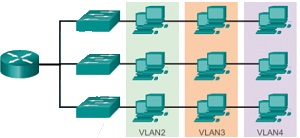
A group of network devices, such as workstations and servers, connected to each other at the same PHYSICAL location are known as a LAN (Local Area Network). On a such network all hosts connected to a standard Layer 2 switch are in the same broadcast domain. A VLAN (Virtual Local Area Network) is a LOGICAL group of network devices, such as workstations and servers that might be on separate physical networks, but share the same broadcast domain.
A VLAN allows a network of computers and users to communicate in a simulated environment as if they exist in a single physical LAN and are sharing a single broadcast domain. The purpose of implementing a VLAN is to improve the performance of a network or apply security features. Higher-end switches allow the functionality and implementation of VLANs.
There are two types of packets on a VLAN, tagged and untagged. An untagged packet is a regular packet like exists on a regular network. The decision of which VLAN an untagged packet belongs to is determined by the switch. A switch can be configured to assign specific ports to specific VLANs.
If a switch configured to allow tagged packets, and the port which receives the packet is configured to allow tagged packets, it knows which ports it can send the packet to. A switch can also be configured to transmit tagged packets, this allows a VLAN to span more than one switch.
More Networking Topologies Articles:
• The Complete Guide to Fiber Optic Connectors
• Technologies for the Internet of Things (IoT)
• Understanding Basic Terms in Indoor Fiber Optic Cable Installation
• Ethernet Bridges
• Routing Technologies, Bandwidth Management and Traffic Shaping
• Cable: Cat5, Cat5e, Cat6, Cat6A ; What's the Difference?
• Proxy Servers
• Network Storage Server Options
• Frame Relay WAN Protocol
• Understanding Wireless LAN Networking

